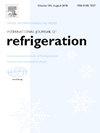一种可持续的加工冷却解决方案:内部冷却的刀架,由纳米制冷剂和电流体动力效应增强
IF 3.5
2区 工程技术
Q1 ENGINEERING, MECHANICAL
International Journal of Refrigeration-revue Internationale Du Froid
Pub Date : 2025-02-12
DOI:10.1016/j.ijrefrig.2025.02.010
引用次数: 0
摘要
切削液的替代品在机械加工中得到了广泛的研究。虽然它们为工具提供润滑和冷却,但它们会带来健康风险,造成环境破坏,并增加制造成本。考虑到世界上许多研究人员一直致力于纳米流体的新应用,我们的目标是评估纳米制冷剂与电流体动力效应(EHD)在类似于内部冷却刀架的设备中的应用,以减少或消除切削液。制备了三种不同浓度的R141b/Al2O3纳米制冷剂,并对其进行了表征。开发了一种类似刀架的加热室,用于循环纳米流体,应用EHD效应,并评估其降低刀具温度的效果。纳米制冷剂在48小时内保持稳定;根据浓度的不同,它们的粘度增加了44-64%。最低浓度纳米制冷剂的导热系数提高了44%。在所有分析条件下,EHD效应都显示出积极的结果,传热系数(h)增加了19%。然而,较高的纳米颗粒浓度导致h值的增加较小。基于传热系数,内部冷却系统证明了减少或消除切削液的可行性。纳米制冷剂与EHD效应相结合,增强了内部冷却方式,延长了刀具寿命。本文章由计算机程序翻译,如有差异,请以英文原文为准。
A sustainable cooling solution for machining: Internally cooled toolholder enhanced by nanorefrigerants and electrohydrodynamic effect
Alternatives to cutting fluids have been extensively researched in machining. While they provide lubrication and cooling for tools, they pose health risks, cause environmental damage, and increase manufacturing costs. Considering that many researchers worldwide have been focusing their efforts on new applications for nanofluids, the objective is to evaluate the application of nanorefrigerants alongside the Electrohydrodynamic Effect (EHD) in a similar device to an internally cooled toolholder in order to reduce or eliminate cutting fluids. R141b/Al2O3 nanorefrigerants with three different concentrations were prepared and subsequently characterized. A heating chamber similar to a toolholder was developed to circulate nanofluids, apply the EHD effect, and evaluate its efficacy in reducing cutting tool temperature. The nanorefrigerants remained stable for up to 48 h; their viscosities increased by 44–64%, depending on concentration. The thermal conductivity of the nanorefrigerant with the lowest concentration increased by 44%. The EHD effect showed positive results in all analyzed conditions, with an increase in the heat transfer coefficient (h) of up to 19%. However, higher nanoparticle concentrations resulted in a smaller increase in the h values. Based on the heat transfer coefficient, the internal cooling system proved viable for reducing or eliminating cutting fluids. The combination of nanorefrigerants and EHD Effect can enhance the internal cooling method, extending tool life.
求助全文
通过发布文献求助,成功后即可免费获取论文全文。
去求助
来源期刊
CiteScore
7.30
自引率
12.80%
发文量
363
审稿时长
3.7 months
期刊介绍:
The International Journal of Refrigeration is published for the International Institute of Refrigeration (IIR) by Elsevier. It is essential reading for all those wishing to keep abreast of research and industrial news in refrigeration, air conditioning and associated fields. This is particularly important in these times of rapid introduction of alternative refrigerants and the emergence of new technology. The journal has published special issues on alternative refrigerants and novel topics in the field of boiling, condensation, heat pumps, food refrigeration, carbon dioxide, ammonia, hydrocarbons, magnetic refrigeration at room temperature, sorptive cooling, phase change materials and slurries, ejector technology, compressors, and solar cooling.
As well as original research papers the International Journal of Refrigeration also includes review articles, papers presented at IIR conferences, short reports and letters describing preliminary results and experimental details, and letters to the Editor on recent areas of discussion and controversy. Other features include forthcoming events, conference reports and book reviews.
Papers are published in either English or French with the IIR news section in both languages.

 求助内容:
求助内容: 应助结果提醒方式:
应助结果提醒方式:


